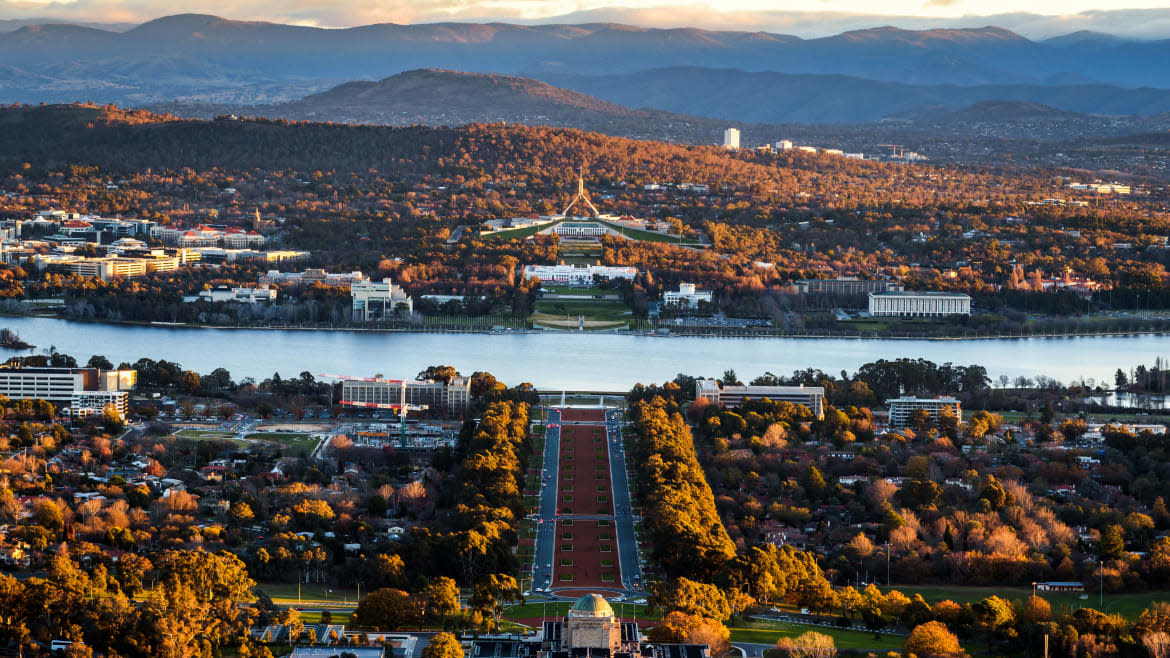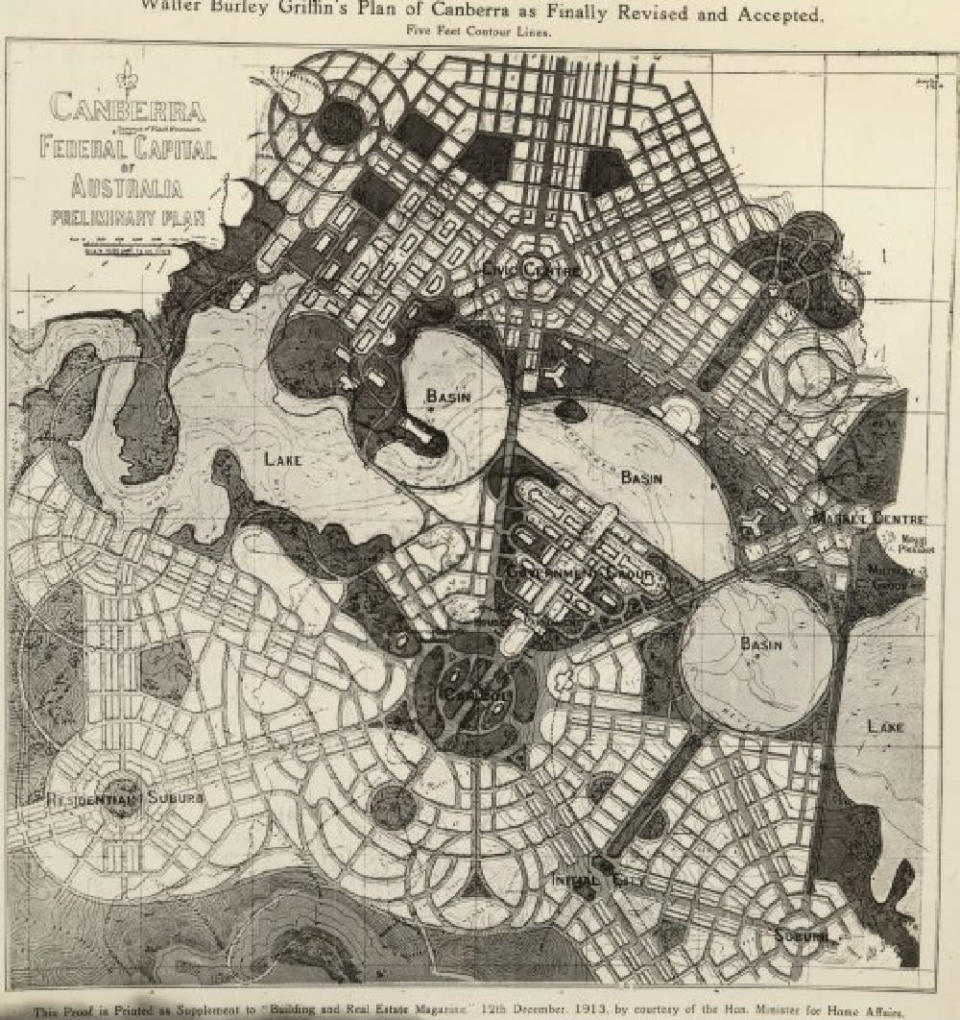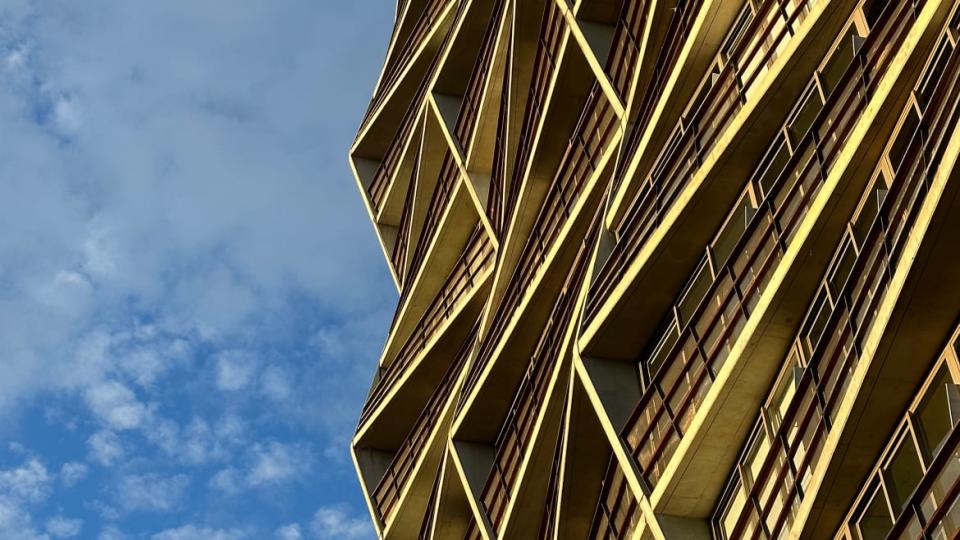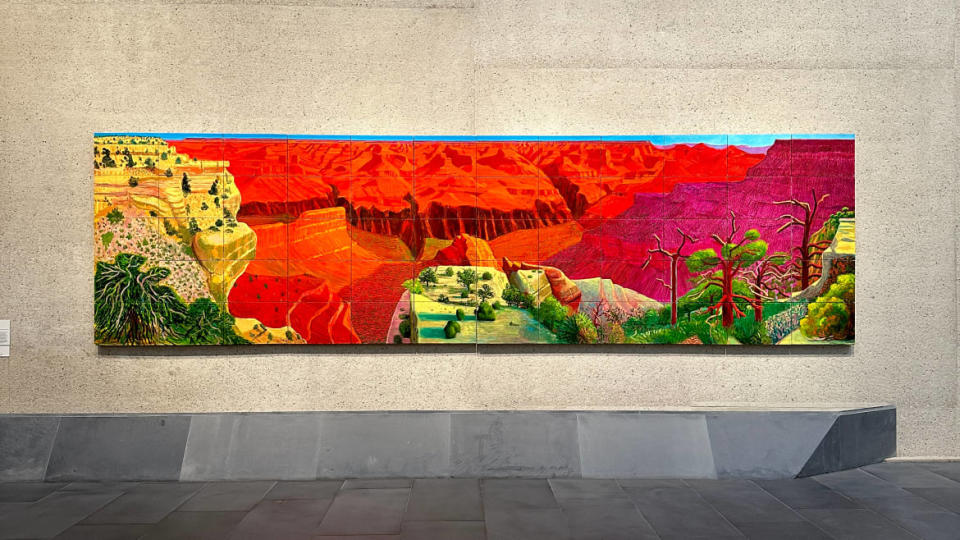This Overlooked Australian City Is an Urbanist’s Dream

- Oops!Something went wrong.Please try again later.
Some places just boggle the mind as to why humans, in the face of such inhospitable landscape, choose to settle there. Then there are cities like Canberra—Australia’s built-from-scratch modern capital. If ever a city was nestled, it’s this one: straddling a curving lake in the verdant trough between low-lying mountains in eastern Australia. It’s here that a little more than a century ago a no-name American husband and wife put forth designs for an entirely new city. Nowadays, though, few American tourists make their way to Australia’s capital.
What they would find is an urbanist’s dream—a city still on its way to “becoming” and one that is a vivid representation of the fights and theories about how a metropolis should be laid out. It’s also a haven for outdoor enthusiasts, surrounded as it is by mountains and in close proximity to the “Australian Alps.” Perhaps most surprising, just outside the city is one of Australia’s lovelier wine regions, one that remains a hidden gem to its own countrymen. That’s why Canberra is the perfect selection for our series on underrated destinations, It’s Still a Big World.
My home for my stay as a guest of VisitCanberra was the A by Adina Canberra, which is located just off the traffic circle marking one of the junctures of the city’s central triangle. It’s a sleek black and glass edifice, with large rooms, a modern gym, and a millennial-core design cafe named ARC that is always lively and full. Along the lakefront, roughly a 10-minute walk away, is the National Capital Exhibition where you should start your visit to Canberra.
It’s not huge, but these few rooms are impeccably done and one of the best museums I’ve been to this year. It details the history of what is now Canberra, from the pre-colonial Aboriginal era on through the planning for the capital city and its ongoing completion. Australians have a reputation for not being too precious, and a taste of that is on display as you enter. Dozens of the names proposed for the new capital city adorn the wall and ceiling. What did turn-of-the-century Australians put forth? Among others: Empire City, Regina, Boomerang, Aryan City, and the very, very on the nose Sydmeladperbrisho and Wheatwoolgold. Canberra, believed to be derived from the local Ngunnawal language’s word for “meeting place,” won out. The spot and name chosen, the Australian government held a global competition in 1911 for designing its new capital.
The competition and planning for the city was overseen by the Minister for Home Affairs, King O’Malley. O’Malley was a bit of a fabulist (he likely wasn’t even eligible to be a minister as he was born in the U.S., not Canada as he claimed) and is believed to have fled the U.S. with accusations of running an insurance scam trailing him. O’Malley’s competition was open to all–bootmakers, soldiers, and haberdashers took their shot–and 127 finished entries came in from all over the world.

The final plan devised by Walter Burley Griffin for Canberra.
Eliel Saarinen took his shot and came in second with a baroque planned city of rigid grand architecture. Alfred Agache, the French architect who planned much of Rio de Janeiro, Curitiba, and Recife, came in third with a design that frankly looked like somebody just transplanted a bunch of random buildings from various European cities. Design number 29 (they were judged anonymously) came in first, and when it was revealed who was behind it all were in for a bit of shock. It came from the relatively unknown American couple, Walter and Marion Griffin.
Their plan was a fusion of the City Beautiful Movement with the aesthetics of the Prairie School. Both of them had worked for Frank Lloyd Wright—in fact Marion was his first employee and is generally credited with being the hand that created the renderings for which Wright would become known. If you happen to be in Melbourne on your Australia trip, she designed the interior of the Capitol Theatre there in a jaw-dropping Mayan Revival style. Unfortunately, almost immediately O’Malley and the government backtracked on the Griffin plan and by 1920 Walter was fired. Today there is only one structure in Canberra designed by Walter that exists and it’s the grave of General Bridges. But if you go to the city’s highest point, the summit of Mount Ainslie, you can see that much of the general idea of their plan survives, with broad avenues connecting national focal points amidst a mostly residential city lost in the foliage.

The sharp angles of the Ovolo Nishi Hotel in Canberra.
If you talk to Australians who have actually been, one of the criticisms levied at Canberra is that it’s quiet. Even in the center you might find yourself alone on the street. But walking around it is like watching the 20th century’s architecture and urban planning unfold. You get pieces of the Revival styles and Prairie influences which gave way to some very cool Midcentury Modern. Then, yes, you get the bad ’70s, ’80s, and ’90s and the city did fall prey to some of the century’s ills like multi-lane roads swooping around and cutting off the lakefront as well as surface parking lots.
Those knocks, though, are heavily mitigated. Contemporary architecture is filling in those lots, often with buildings that show the lessons learned from prior decades. Despite the highways and parking, much of the city by and large melds into the nature from whence it’s wholesale sprung. You’re rarely far from a view of the hazy mountains, trees, and the lake. And in certain neighborhoods, like the popular Braddon Precinct where the city is far from quiet, the built environment is almost irrelevant.
In my handful of trips to Australia over the years I’ve concluded that they don’t seem to be as fussy as Americans about needing polished historic architecture or flashy art gallery-esque spaces for people to flock to an area and fill it. And so while Braddon used to be made up of industrial sites and car yards, today it’s humming with people out to lunch, drinking, shopping, and strolling.
Like most Australian cities, you’ll eat well in Canberra. I still occasionally dream about the eggplant kasundi over stracciatella I devoured at Rebel Rebel my first night in town. And as a recent convert to the church of lemon myrtle, I loved the scallops dressed in it at Corella in the Braddon Precinct. And for those with a sweet tooth, across the street from Corella you’ll find Messina for your gelato fix.
It’s obvious being in Canberra that it’s the ideal place for those who love mid-size city life with quick access to the outdoors. A bigger Australian Boulder, if you will. But what isn’t obvious is that just 30 minutes outside Canberra is one of Australia’s more low-key but delightful wine regions. On my second full day in the city, I tagged along with the charming and easygoing Laura Jallier from Van du Vin (highly recommend!) for a tour of a few of the region’s vineyards.
Our first stop was at the area's most successful and oldest—Clonakilla. It’s best known for its co-fermentation Shiraz Viognier, which often puts it among the top-rated producers in the country. But the most fun might be had while trying its shiraz. One is produced from grapes on the estate and another from a nearby town famed for its cherries. Terroir can often seem like an intangible concept designed to confuse, but with these two you get an accessible lesson. In the first, the white pepper so strong generally around here comes unmistakably through. And in the second, you get a rush of fresh red cherries.
To break up, or soak up, the booze, we stopped in for pizza and more wine at Four Winds Vineyard before cruising on over to Yarrh. If I was to while away the afternoon, it’s here. The view is Tuscany-meets-the-Australian bush. And the pair running it, Fiona Wholohan and Neil McGregor, are lovely and quirky and passionate. They’re exactly the kind of people you’ll want to ask questions to if you’ve ever been too nervous in other wine-tasting settings.
Like any capital city worth its salt, Canberra can put a visitor on a steady diet of museums. There’s the aforementioned NCE, the Australian War Memorial, the Old Parliament House, the National Museum, National Gallery, National Portrait Gallery, and so on. The National Museum is extensive and a bit overwhelming. It’s thematic and not chronological so can be a bit hard to sort, but any exhibit you feel drawn to will give you something fascinating to think over. It might be how the Yuin people in southeast Australia and then whalers collaborated with orcas to hunt for whales. Or the staggering map of how many languages and communities make up Aboriginal Australia. Or perhaps the strange tale of French cabin boy Narcisse Pelletier, who in 1858 was abandoned at sea and adopted by the Uutaalnganu. The National Portrait Gallery is also a great dive into Australian history via its artists, generals, business titans, and politicians.

The spectacular setting for Hockney's painting of the Grand Canyon.
The National Gallery’s Brutalist edifice might look like an Imperial fortress from Star Wars from the outside, but inside it’s a cathedral of art. Aboriginal art is undoubtedly a significant part of the collection, including major pieces from giants like Emily Kame Kngwarreye or my personal favorite, Uta Uta Tjangala. Australian art in general is proudly displayed, but the international collection is top-notch. Jackson Pollock’s Blue Poles is astonishing, and you can wander amongst works from Francis Bacon, Lucian Freud, Lee Krasner, Monet, and so on. Whatever you do, make sure you meander down to the ground level. In this cavernous space are works from Robert Smithson, Salvo, Matthew Barney, Albert Yonathan Setyawan, Arthur Boyd, and a collaborative piece by 10 Aboriginal painters. Running nearly the entire length of one wall is David Hockney’s panorama of the Grand Canyon. The living legend seems to be battling just like the rest of us with how to capture the magnitude of the natural wonder. (While the painting will stop you in your tracks, I think it still pales in comparison to the real thing.)
Before you leave the museum, or Canberra as a whole, wander outside and through the sculpture garden along the lakefront. Yes, there are significant works of art but more than anything it’s just a lovely picturesque set of grounds. Walking around it, you can grasp what the Griffins hoped to achieve here in this new city, and you can see the incredible foundation their vision left for this city to keep becoming.
This is the latest in our series on underrated destinations, It's Still a Big World.
Get the Daily Beast's biggest scoops and scandals delivered right to your inbox. Sign up now.
Stay informed and gain unlimited access to the Daily Beast's unmatched reporting. Subscribe now.

